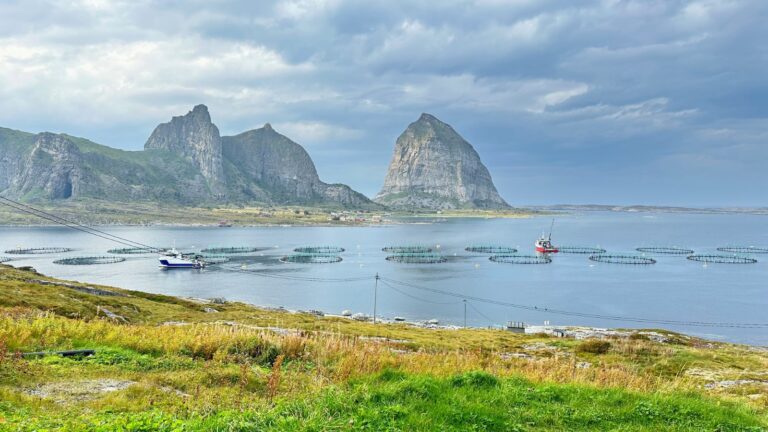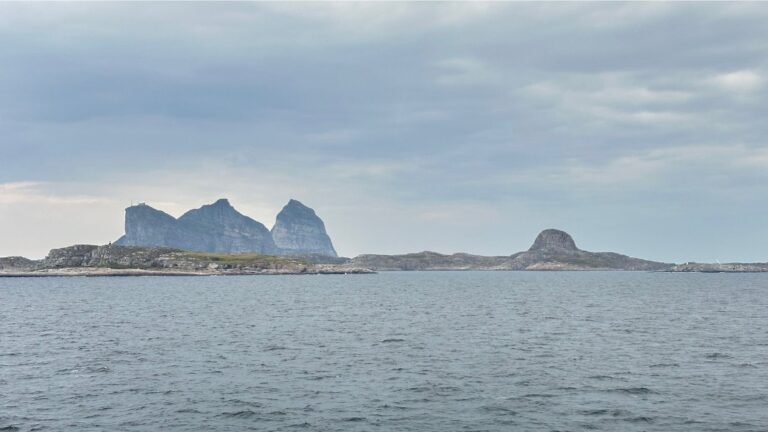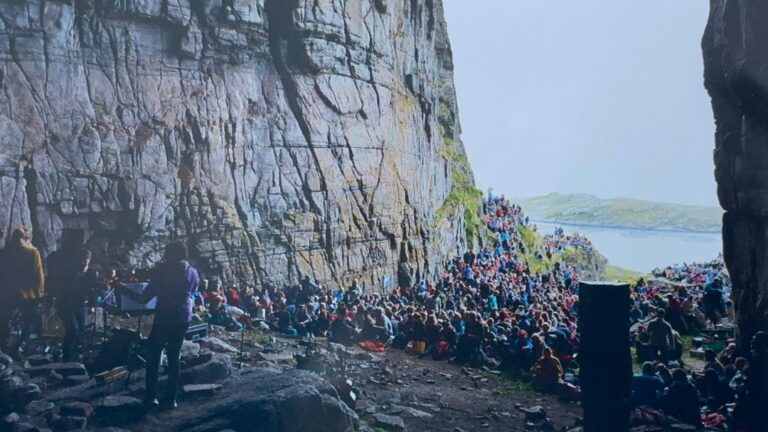These landmark islands off the coast of Norway have a rich history. Here’s everything you need to know about visiting Træna.
I’ve just spent a day in Træna, a remote set of islands far off the coast of Norway near the polar circle that few Norwegians even make it to.

Hidden gem is an overused phrase in travel, but keep scrolling to discover why Træna is exactly that. You’ll see the mountains that define these landmark Norwegian islands, terrific views, and a thriving community that dates back to the Stone Age.
I was on board the Svalbard Line, a relatively new cruise offered by Norwegian company Hurtigruten. Known mostly for their coastal route ferry, the Svalbard Line is a cruise-only service that offers a roundtrip from Bergen to Longyearbyen.
The ports are different from the coastal route. Very different, in fact! One of the ports that attracted me to this route specifically was Træna, a place very few other cruise ships get to.
Video Tour of Træna
First things first, do you prefer videos? If so, check out this 8-minute video all about the islands:
Thanks for watching. If you enjoyed that, please do read on for more information and more photos.
Where is Træna?
You’ll find the Træna archipelago off the Helgeland coast, the southernmost part of what is considered Northern Norway.
The islands are located northwest of Sandnessjøen, and south-southwest of Bodø, and yes, a few hundred people really do live out here.
That fact is hard to believe as you approach the islands, with this mountainous terrain looming ever larger.

There are hundreds of islands and rocky outcrops making up Træna, but only four islands are inhabited: Sanna, Husøy, Sandøy, and Selvær. We would be docking on the most populous island, Husøy.
As we approached Husøy, many more guests joined me at the front of the ship to watch our arrival through a narrow channel, and to see what’s involved with docking here.
Træna’s harbour is a busy one with good facilities, but passenger ships of this size rarely visit.

Aside from the Trollfjord stopping by every few weeks, only a National Geographic Lindblad expedition ship had called at Træna this year, so there was plenty of interest from locals too.
Fun Facts About Træna
I joined a cultural walking tour of Husøy, the main island, led by Ramona who had grown up on the islands. On this walk, I learned a lot about life on the islands.
1. People Have Lived Here Since the Stone Age
With an economy based almost entirely on fishing, the year-round population of Træna has barely changed since the Stone Age.
There’s always been a few hundred people here, earning their living because of the sheltered bays and the deep, cold waters that are rich with fish throughout the year. Today, about 450 people live here.
On Sanna island, there’s a famous cave known as Nature’s Cathedral, believed to have been a meeting place dating back 10,000 years.
2. Træna Has a Music Festival
Every year, a few thousand people flock to the islands for the Træna Festival, surely the music festival with the most spectacular setting in Norway. One of the stages is even inside the famous cave, mentioned above.

Never heard of it? You’re certainly not alone, but it’s well worth finding out more about the event. The Guardian called it “one of the best festivals in Europe that you’ve probably never heard of.”
3. It’s Only Accessible by Boat
There is no airport here, so the only way to reach the islands are by boat. Just one or sometimes two passenger ferries make the trip from the mainland every day, so the people here have learned to be self-sustainable.
Things to Do on Træna
Exploring Træna is best done at your own pace, although organised tours are available such as the cultural walk I took as part of the Svalbard Line port call.
Something to bear in mind on Træna is that due to the remote nature of the community, things can and do change especially with regards to weather and sea conditions. Check opening hours in advance if you are making the journey for something specific.
1. Island Hopping Tour
Explore the tiny settlements, beautiful beaches, and old harbours of the other populated islands of Træna with the scheduled ferry service.
Holmen and Sandøy are ideal for a day trip of walking or swimming, while Sanna brings you up close to Træna’s famous mountain landscape.
2. Visit ‘Nature’s Cathedral’
Sanna Island hosts Kirkehelleren, a large, high-ceiling cave. Visible from the neighbouring island, the cave has become an icon of Træna, and is even used as a stage during the Træna Festival.
Now we head to the main island, Husøy, for the remainder of my recommended things to do.
3. Walk to the Water Tower
A great way to get your bearings, get some exercise, and take in some wonderful views, a walk to the Husøy water tower is a great starting point.
4. Visit Petter Dass Chapel
On the way to the water tower, this cute little chapel turned out to be much newer than I expected.

The Petter Dass Chapel was built in 1997 in memory of the theologian and poet. It’s also dedicated to those who have been lost at sea over the years. In fact, the chapel was actually designed to resemble a boat, best seen from the outside.
5. Visit Aloha Cafe
Yes, there’s a Hawaiian influenced cafe right in the middle of these remote islands in Northern Norway! The cozy, tropical-themed cafe takes its name from the Træna-Hawaii photo.
Locals meet here—on the outside terrace if it’s sunny—to chat over coffee and visitors are, of course, welcome.

There’s beer sold here, and food too, including a delicious selection of homemade cakes. On my visit, some locally-made woollen clothing was also on sale.
6. Enjoy a Swim and Sauna
Swim and sauna sites have grown in popularity across Norway, especially in Oslo. But you can enjoy the activity a world away from the capital too at Træna Badstue-Naust.
An old boat house has been converted into a sauna by a team of architects and local supporters. Regular sessions are organised for locals and visitors. For example, there was an organised trip here available as part of the Svalbard Line port call.
Bookings can also be made via the Facebook page, linked above.
7. See Træna Museum
Træna museum is small but it’s packed with history from photos to historic interiors. It’s worth a look inside, but it won’t take you more than a few minutes unless you have a specific interest.

There are a few exhibitions in the garden too, including a stage which I assume is used for the Træna Festival. A small gift shop was open here, from which I bought a small Træna tote bag.
Whether this shop is open regularly or just in connection with ship visits I am unsure of, but I would guess the latter.
8. Visit Træna Church
A few minutes walk from the cafe, we had the chance to look inside the 18th-century Træna Church, which has space for about half of everyone who lives on the islands.
While this is far from being one of Norway's famous churches, it's well worth inclusion on any cultural tour of the islands.

As with most coastal churches, there's a boat hanging from the ceiling. The contrast of the detailed decoration against the plain wooden walls also caught my eye.
9. Drink at the Waterfront Pub
Last but definitely not least, the pub! On the Husøy waterfront you’ll find Havfolkets Hus (Seaman’s House).
In summer, the restaurant is open daily and has ‘pub evenings’ at weekends. In the off-season, the pub is open on weekends and for specific events. As with the sauna, check the Facebook page of Havfolkets Hus for details on opening hours.
10. Support the Coffee Collective
Okay, one more! If you enjoy one too many beers at Havfolkets Hus, you might need some coffee the next day. There’s no better place to do that than Træna Kaffekollektiv, open during the summer.
Opening hours vary, and pop-up dining events are sometimes held here. So, check the Facebook or Instagram page of the collective to be sure you don’t miss out.
How to Travel to Træna
As mentioned before, there is no airport or fixed road connection to Træna, so the only way to reach the islands is by boat.
The principal ferry connection is from Sandnessjøen, which takes 2.5 hours. To reach here you can take a bus from Mosjøen, which is a stop on the Nordland Line, the Trondheim to Bodø railway.
If you’re travelling from the north, there are potentially easier, albeit less frequent, options from Stokkvågen (connections to Mo i Rana) and Bodø. In general, there are more connections during the summer season.
The easiest way to check the latest schedules is via Reis Nordland, which covers public transport for the whole Nordland county.
Have you ever been to Træna? I'd love to hear how you found the experience, and what recommendations you may have for others planning a trip. Please do head down to the comments and share your thoughts.

